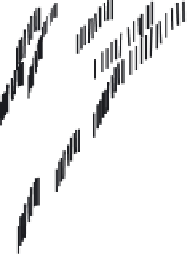Geoscience Reference
In-Depth Information
Box 19.2
Dune generations in Mauritania
Linear dunes dominate sand seas in the western Sahara. In the Azefal, Agneitir and Akchar sand seas of western
Mauritania, three distinct crossing trends of linear dunes can be identified on satellite images (Figure 19.24). From
oldest to youngest they are: (1) a northeast-southwest trending class of large, degraded red brown linear ridges,
(2) a north-northeast trending class of moderate-sized linear dunes, commonly with active crests, that appear and
(3) a north trending class of small simple linear dunes. Field studies of dune sediments and stratigraphy show
that the surface of the two oldest dune generations is littered with Neolithic stone artefacts and pottery and is
underlain by a bioturbated, slightly indurated red-brown sand enriched in silt and clay, which is interpreted as a
paleosol. OSL ages obtained from dunes of the different generations cluster between 25-15 ka (spanning the Last
Glacial Maximum), 10-13 ka (during the Younger Dryas event) and after 5 ka. Modelling of the wind regimes that
produced these dunes using the gross bedform normal (GBN) approach shows that the wind regimes that occurred
during each of these periods were significantly different, leading to the formation of dunes on three superimposed
trends - northeast-southwest, north-northeast to south-southwest and north to south. The trend of the N-S dunes
corresponds closely to the GBN trend for modern winds near the coast, whereas the NE-SW and NNE-SSW dune
trends imply increased sand transport from the east and north to northeast directions, corresponding to enhanced
trade wind circulations (Lancaster
et al.
, 2002).
0
20
km
19 30'N
19 30'N
Dune trends
< 5 ka
10 - 12 ka
15 - 25 ka
16W



















